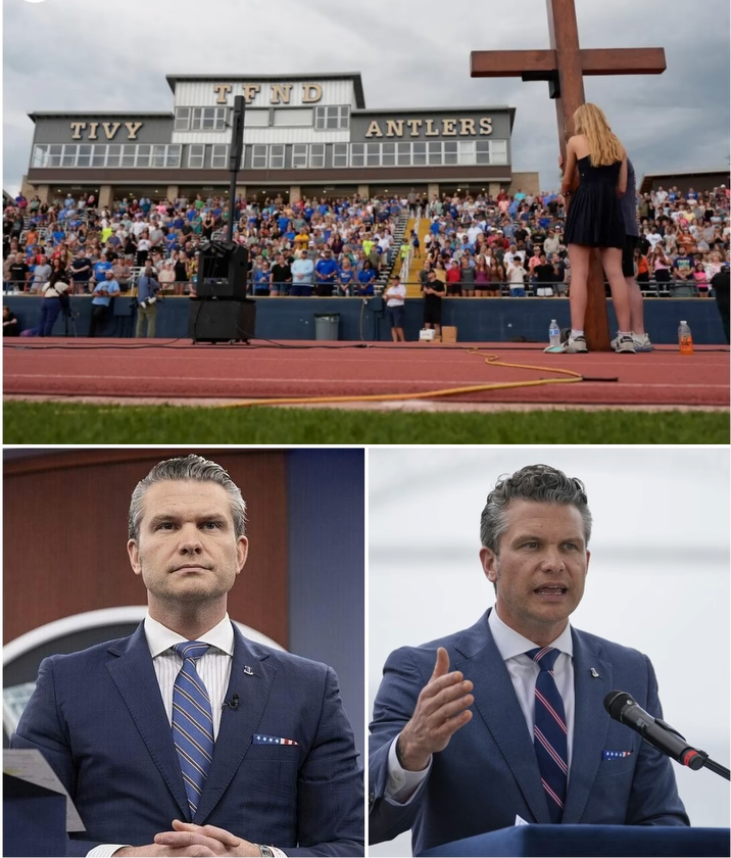On a humid evening in Texas, beneath a sky still heavy with the memory of storm clouds, hundreds gathered at the Texas High School Stadium. They came bearing memories, pain, and the hope of healing. The stadium, usually filled with the roar of football fans, was transformed into a place of solemn remembrance—a sanctuary for those left behind by the devastating floods that had swept through their community.

Rows of folding chairs lined the field, each occupied by someone touched by tragedy. Families clung to portraits of their loved ones, their faces illuminated by the soft, trembling light of candles. The air was thick with the scent of rain, wax, and sorrow. As dusk settled, the only sounds were the quiet sobs of mourners and the gentle rustle of programs in trembling hands.
A Community United in Loss
The floods had come swiftly, leaving chaos in their wake. Streets became rivers, homes were swallowed whole, and lives were forever changed. For days, the community had watched the waters rise and waited helplessly as rescue teams searched for survivors. When the waters finally receded, they left behind a silence that was almost unbearable—a silence filled with unanswered questions and unimaginable grief.
It was in this silence that the community decided to gather. The vigil was more than a ceremony; it was a collective act of resilience, a way to share the burden of loss and begin the long journey toward healing.
An Unexpected Voice
As the night deepened, organizers invited Pete Hegseth to the stage. Known to many as a television host and veteran, Pete was not a native Texan, but his presence brought a sense of gravity to the event. He stepped into the spotlight, his figure outlined against the stadium’s floodlights. For a moment, he simply stood there, looking out over the crowd—at the mothers clutching photographs, the children huddled together, the fathers with stoic faces and trembling hands.
When he finally spoke, his voice was soft, almost hesitant. “I stand before you not as a stranger, but as someone who knows loss,” he began. “I know what it means to look for answers that don’t come, to ache for a voice you’ll never hear again.”
Words That Moved a Crowd
As Pete spoke, the crowd grew still. His words were not polished or rehearsed. Instead, they were raw and real—words that spoke directly to the aching hearts gathered before him.
His voice broke as he described the families who had lost everything. “You are not alone,” he said, his eyes glistening with tears. “Your pain is our pain. Your loss is our loss. And together, we will find a way forward.”
A Wave of Emotion
Something shifted in the stadium as Pete continued. People began to weep openly, their grief no longer hidden behind stoic faces. Strangers reached for each other’s hands. Old friends embraced. Children clung to their parents, seeking comfort in the warmth of their arms.
Pete did not offer easy answers or empty promises. Instead, he offered something far more precious: the assurance that it was okay to grieve, that it was okay to feel lost, and that healing would come—not all at once, but in small, steady steps.
He urged the crowd to lean on one another, to share their stories, to honor the memories of those they had lost by living lives filled with compassion and courage. “We cannot change what has happened,” he said, “but we can choose how we move forward. We can choose to carry the love of those we’ve lost with us, every day.”
Brady’s Moment of Hope
As Pete finished, a hush fell over the stadium. Then, from the back of the crowd, a young man named Brady—himself a survivor of the floods—stepped forward. His hands shook as he took the microphone, but his voice was clear.
“I lost my brother in the floods,” Brady said, his voice wavering. “For weeks, I didn’t think I could go on. But tonight, hearing these words, seeing all of you here… I know I’m not alone. I know my brother’s memory lives on in every act of kindness, every hug, every tear.”
Brady’s words, simple but sincere, seemed to crystallize the emotions of the night. He didn’t just bring words—he brought hope. Under the stadium lights, surrounded by friends and strangers alike, the pain that had weighed so heavily on the crowd began to transform. Grief turned into strength, loss into unity.
A Night to Remember
As the vigil drew to a close, families lit their candles and placed them along the edge of the field, creating a river of light that shimmered in the darkness. The names of the lost were read aloud, each one met with a moment of silence. Some prayed, others sang softly, and many simply stood together, letting the collective warmth of the crowd begin to heal the wounds left by the storm.
Pete Hegseth remained on the field long after the official ceremony ended, embracing mourners, listening to their stories, and offering quiet words of comfort. “Tonight was about more than remembering the past,” he said to a reporter. “It was about finding the strength to face the future—together.”
A Community Begins to Heal
In the weeks that followed, the memory of that night lingered in the hearts of those who attended. The pain of loss remained, but so did the sense of hope that had blossomed under the stadium lights. Neighbors checked on one another more often. Volunteers rebuilt homes side by side. Children played in the streets again, their laughter a testament to the resilience of the human spirit.
And on that unforgettable night at the Texas High School Stadium, it all began with a few words, a few tears, and the courage to believe that healing was possible.